Negligence and Vicarious Liability in Law
VerifiedAdded on 2020/02/05
|13
|3548
|138
Report
AI Summary
This assignment delves into the legal principles of negligence, contributory negligence, and illegal actions within a contract context. It examines how these concepts apply to scenarios involving both individual and employer liability. Two case studies are analyzed: one involving a car accident where both the driver and a local council are potentially liable for injuries, and another where an employee assaults a coworker during work, making the employer vicariously liable. The assignment concludes by emphasizing the importance of fulfilling contractual duties and exercising reasonable care to avoid legal repercussions.
Contribute Materials
Your contribution can guide someone’s learning journey. Share your
documents today.
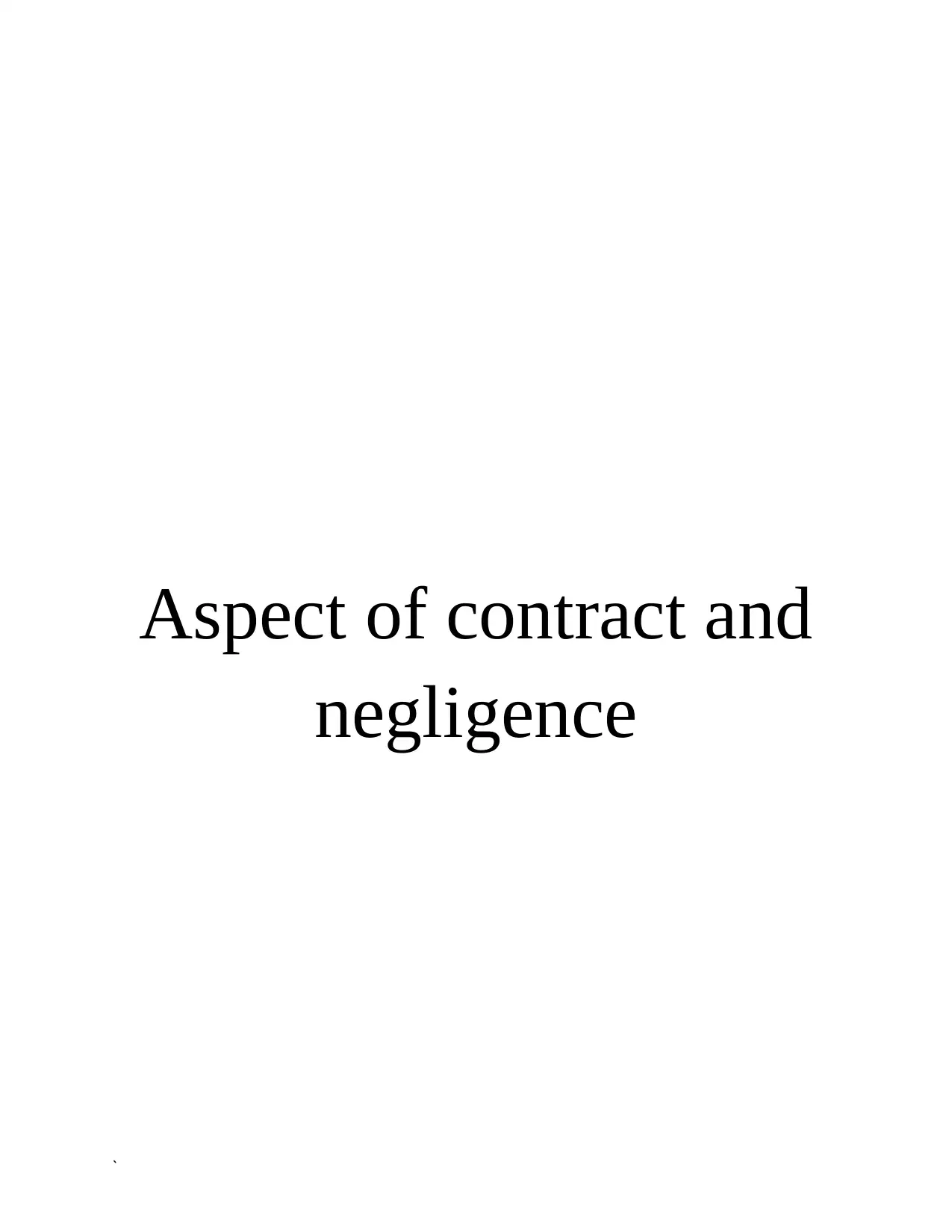
Aspect of contract and
negligence
`
negligence
`
Secure Best Marks with AI Grader
Need help grading? Try our AI Grader for instant feedback on your assignments.

Table of Contents
INTRODUCTION.......................................................................................................................................3
TASK 1.......................................................................................................................................................3
Essential contract elements......................................................................................................................3
Impact of different types of contract........................................................................................................4
Contract terms, meaning and their impact...............................................................................................5
TASK 2.......................................................................................................................................................5
Application of contract elements in given case scenario..........................................................................5
Apply the law on terms in different contracts..........................................................................................6
Evaluation of effect on different terms of law.........................................................................................7
TASK 3.......................................................................................................................................................7
Contrast liability in tort with contractual liability....................................................................................7
Explaining the nature of liability in negligence.......................................................................................8
Vicarious liability of a business...............................................................................................................9
TASK 4.......................................................................................................................................................9
Apply the tort of negligence and defences...............................................................................................9
Apply the elements of vicarious liability...............................................................................................10
CONCLUSION.........................................................................................................................................10
REFERENCES..........................................................................................................................................12
`
INTRODUCTION.......................................................................................................................................3
TASK 1.......................................................................................................................................................3
Essential contract elements......................................................................................................................3
Impact of different types of contract........................................................................................................4
Contract terms, meaning and their impact...............................................................................................5
TASK 2.......................................................................................................................................................5
Application of contract elements in given case scenario..........................................................................5
Apply the law on terms in different contracts..........................................................................................6
Evaluation of effect on different terms of law.........................................................................................7
TASK 3.......................................................................................................................................................7
Contrast liability in tort with contractual liability....................................................................................7
Explaining the nature of liability in negligence.......................................................................................8
Vicarious liability of a business...............................................................................................................9
TASK 4.......................................................................................................................................................9
Apply the tort of negligence and defences...............................................................................................9
Apply the elements of vicarious liability...............................................................................................10
CONCLUSION.........................................................................................................................................10
REFERENCES..........................................................................................................................................12
`
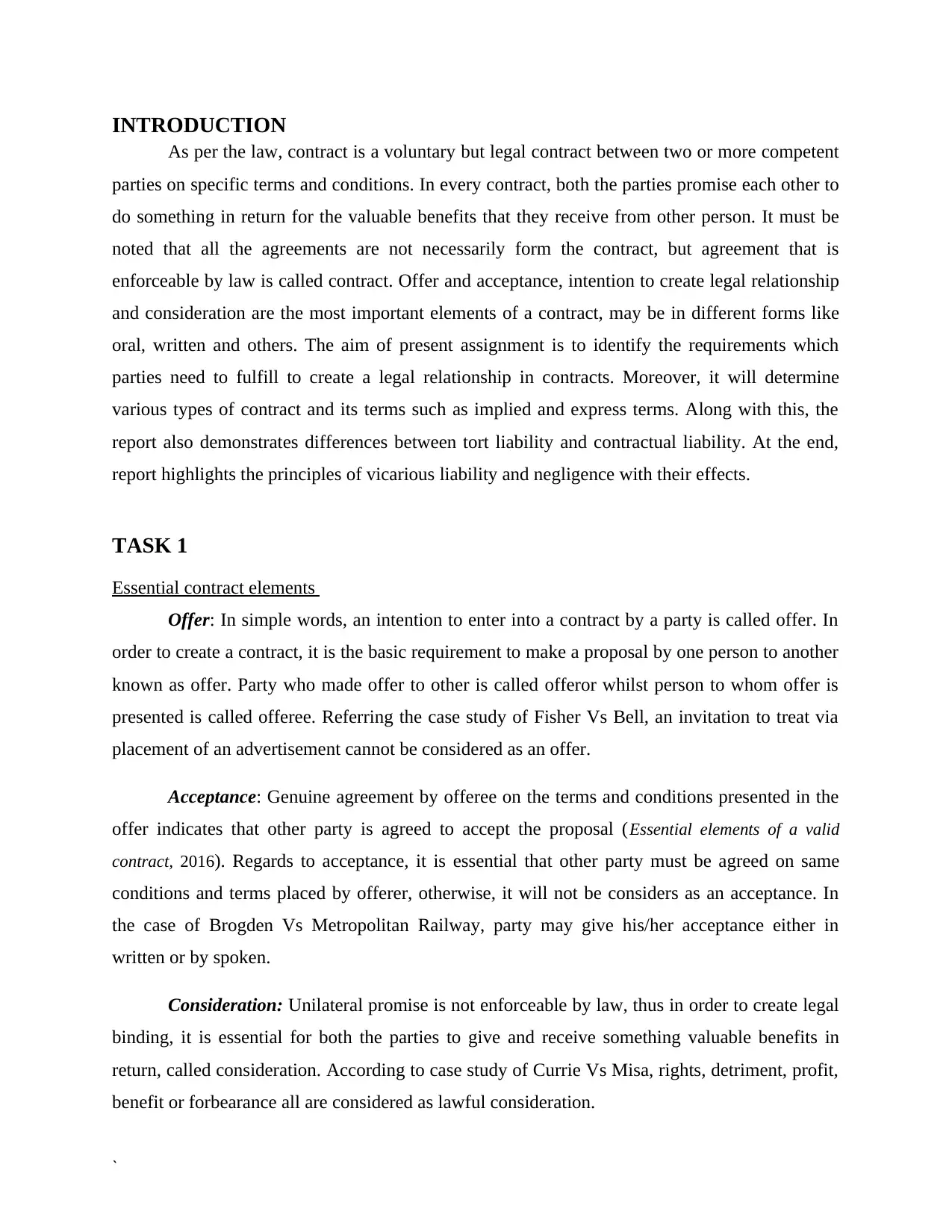
INTRODUCTION
As per the law, contract is a voluntary but legal contract between two or more competent
parties on specific terms and conditions. In every contract, both the parties promise each other to
do something in return for the valuable benefits that they receive from other person. It must be
noted that all the agreements are not necessarily form the contract, but agreement that is
enforceable by law is called contract. Offer and acceptance, intention to create legal relationship
and consideration are the most important elements of a contract, may be in different forms like
oral, written and others. The aim of present assignment is to identify the requirements which
parties need to fulfill to create a legal relationship in contracts. Moreover, it will determine
various types of contract and its terms such as implied and express terms. Along with this, the
report also demonstrates differences between tort liability and contractual liability. At the end,
report highlights the principles of vicarious liability and negligence with their effects.
TASK 1
Essential contract elements
Offer: In simple words, an intention to enter into a contract by a party is called offer. In
order to create a contract, it is the basic requirement to make a proposal by one person to another
known as offer. Party who made offer to other is called offeror whilst person to whom offer is
presented is called offeree. Referring the case study of Fisher Vs Bell, an invitation to treat via
placement of an advertisement cannot be considered as an offer.
Acceptance: Genuine agreement by offeree on the terms and conditions presented in the
offer indicates that other party is agreed to accept the proposal (Essential elements of a valid
contract, 2016). Regards to acceptance, it is essential that other party must be agreed on same
conditions and terms placed by offerer, otherwise, it will not be considers as an acceptance. In
the case of Brogden Vs Metropolitan Railway, party may give his/her acceptance either in
written or by spoken.
Consideration: Unilateral promise is not enforceable by law, thus in order to create legal
binding, it is essential for both the parties to give and receive something valuable benefits in
return, called consideration. According to case study of Currie Vs Misa, rights, detriment, profit,
benefit or forbearance all are considered as lawful consideration.
`
As per the law, contract is a voluntary but legal contract between two or more competent
parties on specific terms and conditions. In every contract, both the parties promise each other to
do something in return for the valuable benefits that they receive from other person. It must be
noted that all the agreements are not necessarily form the contract, but agreement that is
enforceable by law is called contract. Offer and acceptance, intention to create legal relationship
and consideration are the most important elements of a contract, may be in different forms like
oral, written and others. The aim of present assignment is to identify the requirements which
parties need to fulfill to create a legal relationship in contracts. Moreover, it will determine
various types of contract and its terms such as implied and express terms. Along with this, the
report also demonstrates differences between tort liability and contractual liability. At the end,
report highlights the principles of vicarious liability and negligence with their effects.
TASK 1
Essential contract elements
Offer: In simple words, an intention to enter into a contract by a party is called offer. In
order to create a contract, it is the basic requirement to make a proposal by one person to another
known as offer. Party who made offer to other is called offeror whilst person to whom offer is
presented is called offeree. Referring the case study of Fisher Vs Bell, an invitation to treat via
placement of an advertisement cannot be considered as an offer.
Acceptance: Genuine agreement by offeree on the terms and conditions presented in the
offer indicates that other party is agreed to accept the proposal (Essential elements of a valid
contract, 2016). Regards to acceptance, it is essential that other party must be agreed on same
conditions and terms placed by offerer, otherwise, it will not be considers as an acceptance. In
the case of Brogden Vs Metropolitan Railway, party may give his/her acceptance either in
written or by spoken.
Consideration: Unilateral promise is not enforceable by law, thus in order to create legal
binding, it is essential for both the parties to give and receive something valuable benefits in
return, called consideration. According to case study of Currie Vs Misa, rights, detriment, profit,
benefit or forbearance all are considered as lawful consideration.
`
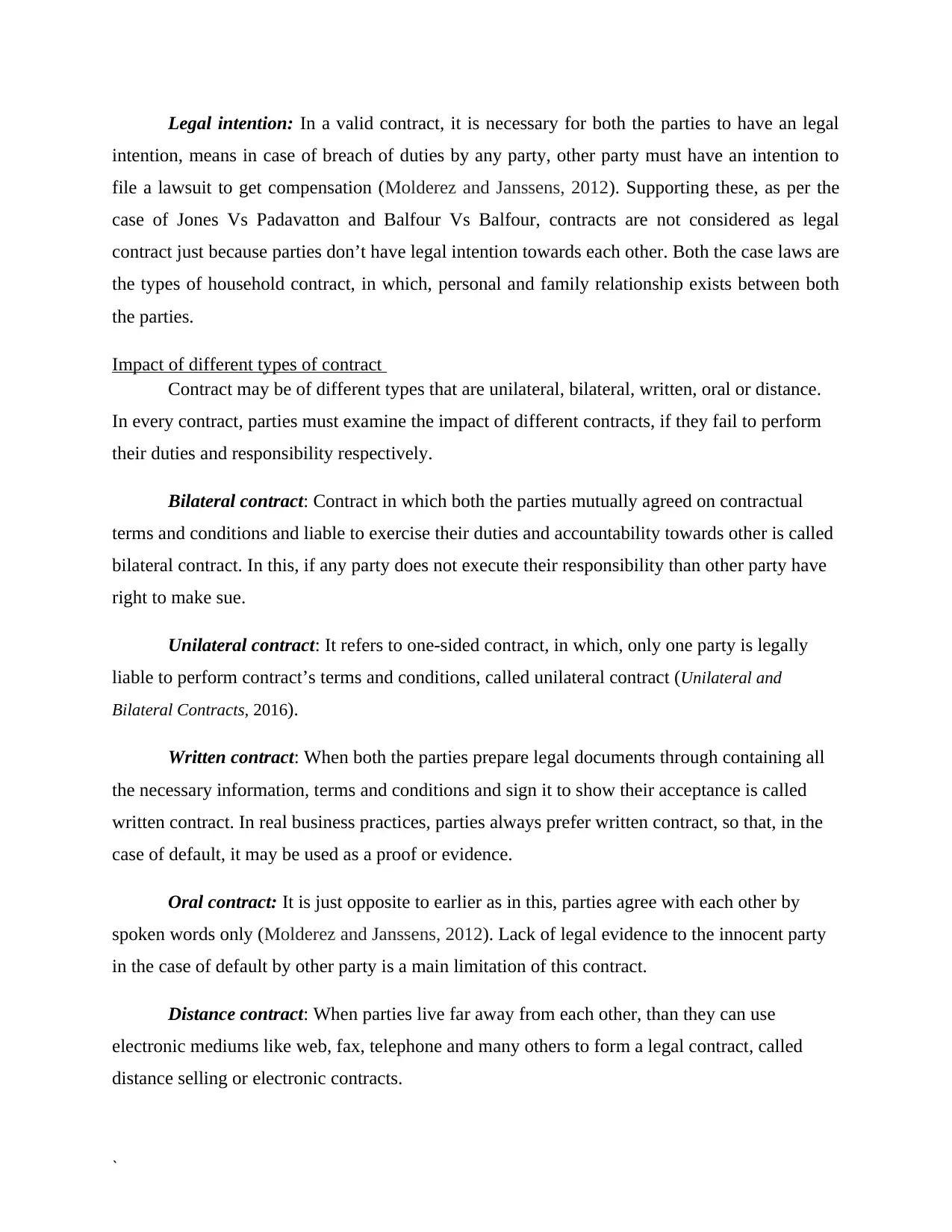
Legal intention: In a valid contract, it is necessary for both the parties to have an legal
intention, means in case of breach of duties by any party, other party must have an intention to
file a lawsuit to get compensation (Molderez and Janssens, 2012). Supporting these, as per the
case of Jones Vs Padavatton and Balfour Vs Balfour, contracts are not considered as legal
contract just because parties don’t have legal intention towards each other. Both the case laws are
the types of household contract, in which, personal and family relationship exists between both
the parties.
Impact of different types of contract
Contract may be of different types that are unilateral, bilateral, written, oral or distance.
In every contract, parties must examine the impact of different contracts, if they fail to perform
their duties and responsibility respectively.
Bilateral contract: Contract in which both the parties mutually agreed on contractual
terms and conditions and liable to exercise their duties and accountability towards other is called
bilateral contract. In this, if any party does not execute their responsibility than other party have
right to make sue.
Unilateral contract: It refers to one-sided contract, in which, only one party is legally
liable to perform contract’s terms and conditions, called unilateral contract (Unilateral and
Bilateral Contracts, 2016).
Written contract: When both the parties prepare legal documents through containing all
the necessary information, terms and conditions and sign it to show their acceptance is called
written contract. In real business practices, parties always prefer written contract, so that, in the
case of default, it may be used as a proof or evidence.
Oral contract: It is just opposite to earlier as in this, parties agree with each other by
spoken words only (Molderez and Janssens, 2012). Lack of legal evidence to the innocent party
in the case of default by other party is a main limitation of this contract.
Distance contract: When parties live far away from each other, than they can use
electronic mediums like web, fax, telephone and many others to form a legal contract, called
distance selling or electronic contracts.
`
intention, means in case of breach of duties by any party, other party must have an intention to
file a lawsuit to get compensation (Molderez and Janssens, 2012). Supporting these, as per the
case of Jones Vs Padavatton and Balfour Vs Balfour, contracts are not considered as legal
contract just because parties don’t have legal intention towards each other. Both the case laws are
the types of household contract, in which, personal and family relationship exists between both
the parties.
Impact of different types of contract
Contract may be of different types that are unilateral, bilateral, written, oral or distance.
In every contract, parties must examine the impact of different contracts, if they fail to perform
their duties and responsibility respectively.
Bilateral contract: Contract in which both the parties mutually agreed on contractual
terms and conditions and liable to exercise their duties and accountability towards other is called
bilateral contract. In this, if any party does not execute their responsibility than other party have
right to make sue.
Unilateral contract: It refers to one-sided contract, in which, only one party is legally
liable to perform contract’s terms and conditions, called unilateral contract (Unilateral and
Bilateral Contracts, 2016).
Written contract: When both the parties prepare legal documents through containing all
the necessary information, terms and conditions and sign it to show their acceptance is called
written contract. In real business practices, parties always prefer written contract, so that, in the
case of default, it may be used as a proof or evidence.
Oral contract: It is just opposite to earlier as in this, parties agree with each other by
spoken words only (Molderez and Janssens, 2012). Lack of legal evidence to the innocent party
in the case of default by other party is a main limitation of this contract.
Distance contract: When parties live far away from each other, than they can use
electronic mediums like web, fax, telephone and many others to form a legal contract, called
distance selling or electronic contracts.
`
Secure Best Marks with AI Grader
Need help grading? Try our AI Grader for instant feedback on your assignments.
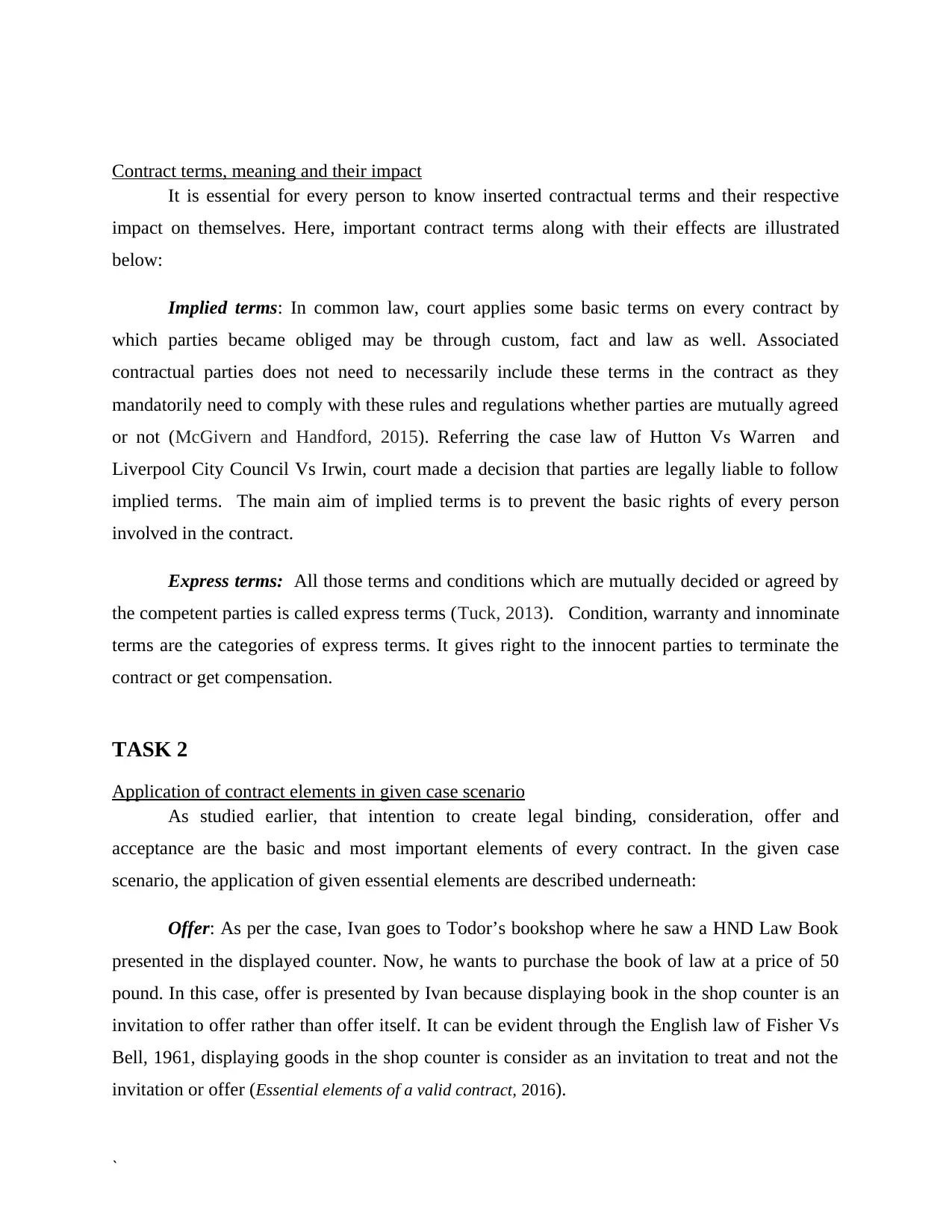
Contract terms, meaning and their impact
It is essential for every person to know inserted contractual terms and their respective
impact on themselves. Here, important contract terms along with their effects are illustrated
below:
Implied terms: In common law, court applies some basic terms on every contract by
which parties became obliged may be through custom, fact and law as well. Associated
contractual parties does not need to necessarily include these terms in the contract as they
mandatorily need to comply with these rules and regulations whether parties are mutually agreed
or not (McGivern and Handford, 2015). Referring the case law of Hutton Vs Warren and
Liverpool City Council Vs Irwin, court made a decision that parties are legally liable to follow
implied terms. The main aim of implied terms is to prevent the basic rights of every person
involved in the contract.
Express terms: All those terms and conditions which are mutually decided or agreed by
the competent parties is called express terms (Tuck, 2013). Condition, warranty and innominate
terms are the categories of express terms. It gives right to the innocent parties to terminate the
contract or get compensation.
TASK 2
Application of contract elements in given case scenario
As studied earlier, that intention to create legal binding, consideration, offer and
acceptance are the basic and most important elements of every contract. In the given case
scenario, the application of given essential elements are described underneath:
Offer: As per the case, Ivan goes to Todor’s bookshop where he saw a HND Law Book
presented in the displayed counter. Now, he wants to purchase the book of law at a price of 50
pound. In this case, offer is presented by Ivan because displaying book in the shop counter is an
invitation to offer rather than offer itself. It can be evident through the English law of Fisher Vs
Bell, 1961, displaying goods in the shop counter is consider as an invitation to treat and not the
invitation or offer (Essential elements of a valid contract, 2016).
`
It is essential for every person to know inserted contractual terms and their respective
impact on themselves. Here, important contract terms along with their effects are illustrated
below:
Implied terms: In common law, court applies some basic terms on every contract by
which parties became obliged may be through custom, fact and law as well. Associated
contractual parties does not need to necessarily include these terms in the contract as they
mandatorily need to comply with these rules and regulations whether parties are mutually agreed
or not (McGivern and Handford, 2015). Referring the case law of Hutton Vs Warren and
Liverpool City Council Vs Irwin, court made a decision that parties are legally liable to follow
implied terms. The main aim of implied terms is to prevent the basic rights of every person
involved in the contract.
Express terms: All those terms and conditions which are mutually decided or agreed by
the competent parties is called express terms (Tuck, 2013). Condition, warranty and innominate
terms are the categories of express terms. It gives right to the innocent parties to terminate the
contract or get compensation.
TASK 2
Application of contract elements in given case scenario
As studied earlier, that intention to create legal binding, consideration, offer and
acceptance are the basic and most important elements of every contract. In the given case
scenario, the application of given essential elements are described underneath:
Offer: As per the case, Ivan goes to Todor’s bookshop where he saw a HND Law Book
presented in the displayed counter. Now, he wants to purchase the book of law at a price of 50
pound. In this case, offer is presented by Ivan because displaying book in the shop counter is an
invitation to offer rather than offer itself. It can be evident through the English law of Fisher Vs
Bell, 1961, displaying goods in the shop counter is consider as an invitation to treat and not the
invitation or offer (Essential elements of a valid contract, 2016).
`
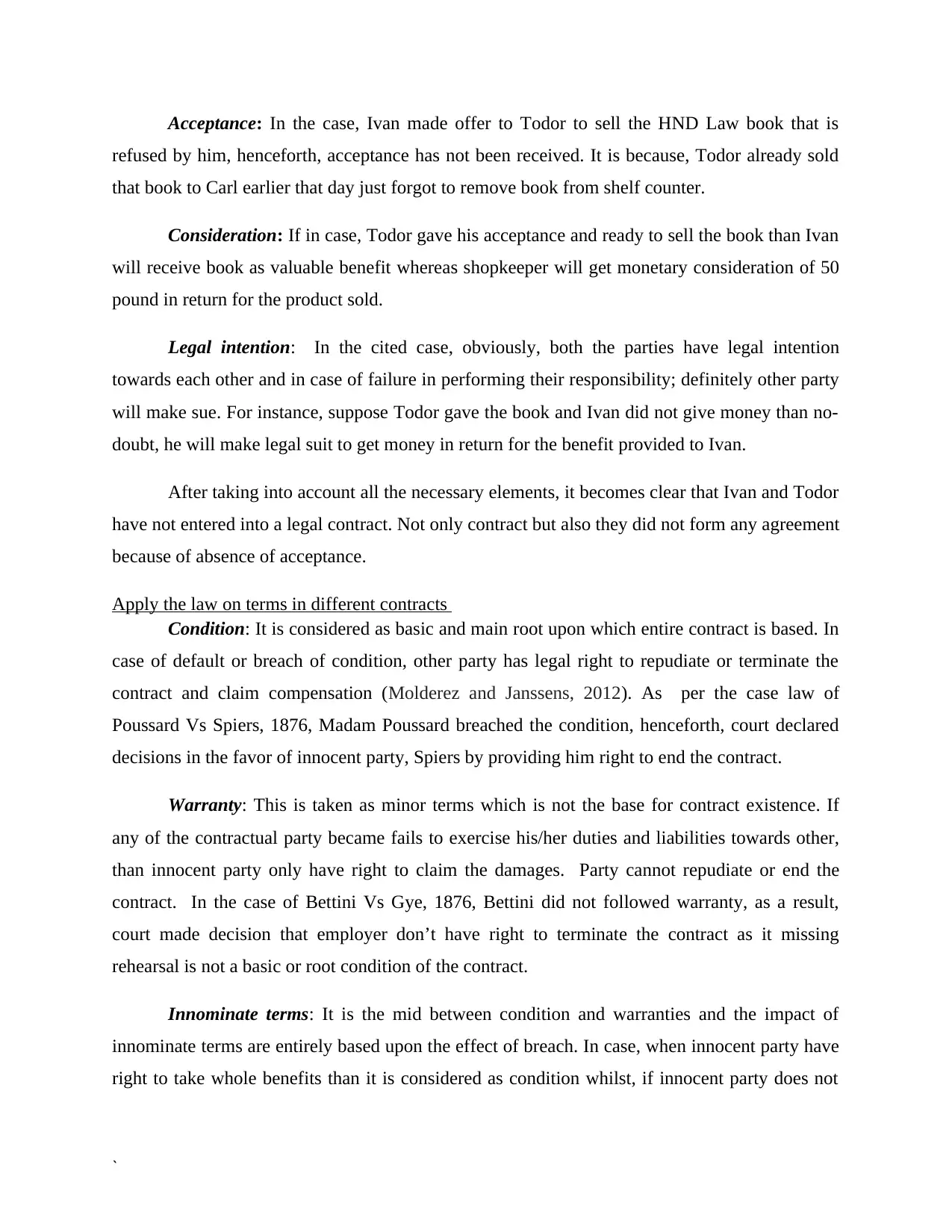
Acceptance: In the case, Ivan made offer to Todor to sell the HND Law book that is
refused by him, henceforth, acceptance has not been received. It is because, Todor already sold
that book to Carl earlier that day just forgot to remove book from shelf counter.
Consideration: If in case, Todor gave his acceptance and ready to sell the book than Ivan
will receive book as valuable benefit whereas shopkeeper will get monetary consideration of 50
pound in return for the product sold.
Legal intention: In the cited case, obviously, both the parties have legal intention
towards each other and in case of failure in performing their responsibility; definitely other party
will make sue. For instance, suppose Todor gave the book and Ivan did not give money than no-
doubt, he will make legal suit to get money in return for the benefit provided to Ivan.
After taking into account all the necessary elements, it becomes clear that Ivan and Todor
have not entered into a legal contract. Not only contract but also they did not form any agreement
because of absence of acceptance.
Apply the law on terms in different contracts
Condition: It is considered as basic and main root upon which entire contract is based. In
case of default or breach of condition, other party has legal right to repudiate or terminate the
contract and claim compensation (Molderez and Janssens, 2012). As per the case law of
Poussard Vs Spiers, 1876, Madam Poussard breached the condition, henceforth, court declared
decisions in the favor of innocent party, Spiers by providing him right to end the contract.
Warranty: This is taken as minor terms which is not the base for contract existence. If
any of the contractual party became fails to exercise his/her duties and liabilities towards other,
than innocent party only have right to claim the damages. Party cannot repudiate or end the
contract. In the case of Bettini Vs Gye, 1876, Bettini did not followed warranty, as a result,
court made decision that employer don’t have right to terminate the contract as it missing
rehearsal is not a basic or root condition of the contract.
Innominate terms: It is the mid between condition and warranties and the impact of
innominate terms are entirely based upon the effect of breach. In case, when innocent party have
right to take whole benefits than it is considered as condition whilst, if innocent party does not
`
refused by him, henceforth, acceptance has not been received. It is because, Todor already sold
that book to Carl earlier that day just forgot to remove book from shelf counter.
Consideration: If in case, Todor gave his acceptance and ready to sell the book than Ivan
will receive book as valuable benefit whereas shopkeeper will get monetary consideration of 50
pound in return for the product sold.
Legal intention: In the cited case, obviously, both the parties have legal intention
towards each other and in case of failure in performing their responsibility; definitely other party
will make sue. For instance, suppose Todor gave the book and Ivan did not give money than no-
doubt, he will make legal suit to get money in return for the benefit provided to Ivan.
After taking into account all the necessary elements, it becomes clear that Ivan and Todor
have not entered into a legal contract. Not only contract but also they did not form any agreement
because of absence of acceptance.
Apply the law on terms in different contracts
Condition: It is considered as basic and main root upon which entire contract is based. In
case of default or breach of condition, other party has legal right to repudiate or terminate the
contract and claim compensation (Molderez and Janssens, 2012). As per the case law of
Poussard Vs Spiers, 1876, Madam Poussard breached the condition, henceforth, court declared
decisions in the favor of innocent party, Spiers by providing him right to end the contract.
Warranty: This is taken as minor terms which is not the base for contract existence. If
any of the contractual party became fails to exercise his/her duties and liabilities towards other,
than innocent party only have right to claim the damages. Party cannot repudiate or end the
contract. In the case of Bettini Vs Gye, 1876, Bettini did not followed warranty, as a result,
court made decision that employer don’t have right to terminate the contract as it missing
rehearsal is not a basic or root condition of the contract.
Innominate terms: It is the mid between condition and warranties and the impact of
innominate terms are entirely based upon the effect of breach. In case, when innocent party have
right to take whole benefits than it is considered as condition whilst, if innocent party does not
`
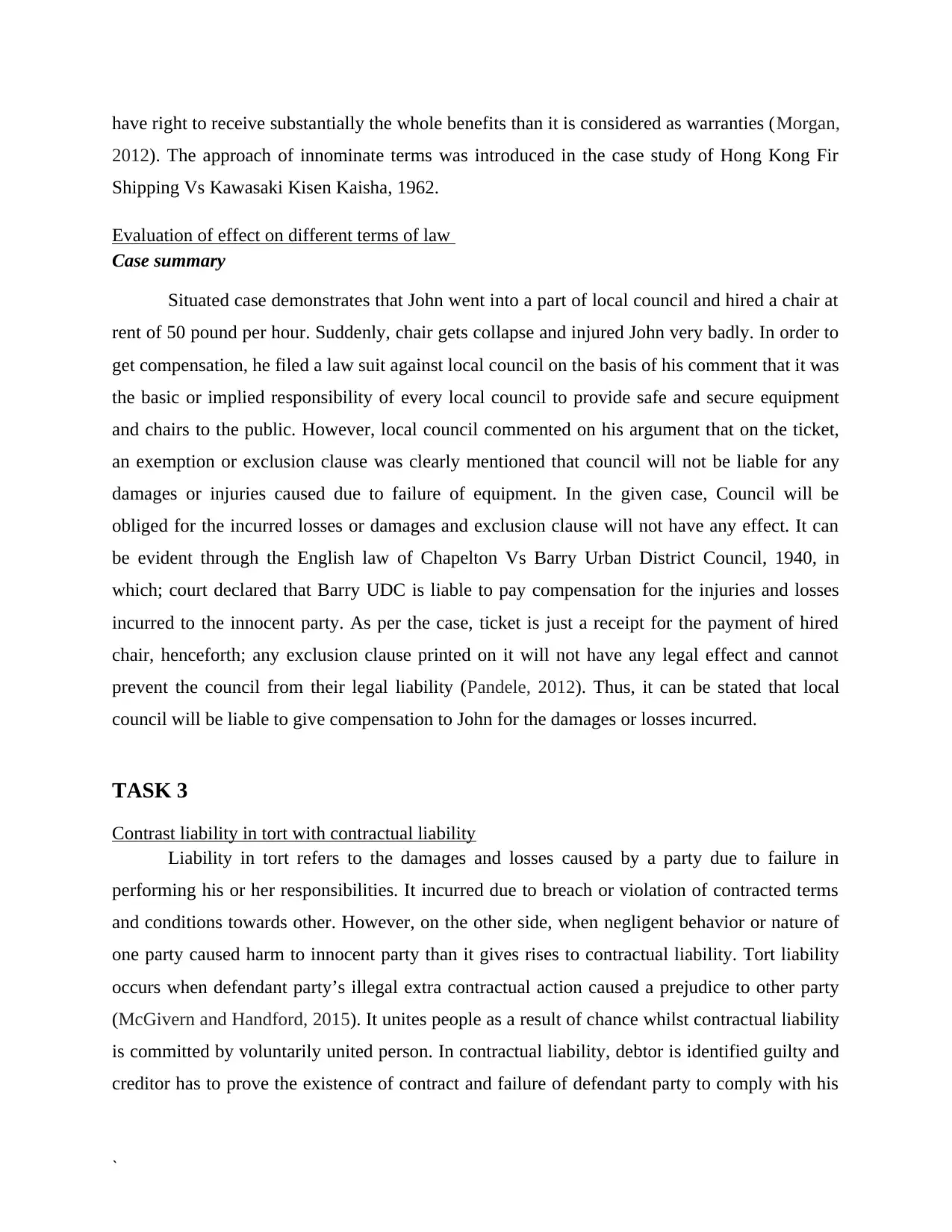
have right to receive substantially the whole benefits than it is considered as warranties (Morgan,
2012). The approach of innominate terms was introduced in the case study of Hong Kong Fir
Shipping Vs Kawasaki Kisen Kaisha, 1962.
Evaluation of effect on different terms of law
Case summary
Situated case demonstrates that John went into a part of local council and hired a chair at
rent of 50 pound per hour. Suddenly, chair gets collapse and injured John very badly. In order to
get compensation, he filed a law suit against local council on the basis of his comment that it was
the basic or implied responsibility of every local council to provide safe and secure equipment
and chairs to the public. However, local council commented on his argument that on the ticket,
an exemption or exclusion clause was clearly mentioned that council will not be liable for any
damages or injuries caused due to failure of equipment. In the given case, Council will be
obliged for the incurred losses or damages and exclusion clause will not have any effect. It can
be evident through the English law of Chapelton Vs Barry Urban District Council, 1940, in
which; court declared that Barry UDC is liable to pay compensation for the injuries and losses
incurred to the innocent party. As per the case, ticket is just a receipt for the payment of hired
chair, henceforth; any exclusion clause printed on it will not have any legal effect and cannot
prevent the council from their legal liability (Pandele, 2012). Thus, it can be stated that local
council will be liable to give compensation to John for the damages or losses incurred.
TASK 3
Contrast liability in tort with contractual liability
Liability in tort refers to the damages and losses caused by a party due to failure in
performing his or her responsibilities. It incurred due to breach or violation of contracted terms
and conditions towards other. However, on the other side, when negligent behavior or nature of
one party caused harm to innocent party than it gives rises to contractual liability. Tort liability
occurs when defendant party’s illegal extra contractual action caused a prejudice to other party
(McGivern and Handford, 2015). It unites people as a result of chance whilst contractual liability
is committed by voluntarily united person. In contractual liability, debtor is identified guilty and
creditor has to prove the existence of contract and failure of defendant party to comply with his
`
2012). The approach of innominate terms was introduced in the case study of Hong Kong Fir
Shipping Vs Kawasaki Kisen Kaisha, 1962.
Evaluation of effect on different terms of law
Case summary
Situated case demonstrates that John went into a part of local council and hired a chair at
rent of 50 pound per hour. Suddenly, chair gets collapse and injured John very badly. In order to
get compensation, he filed a law suit against local council on the basis of his comment that it was
the basic or implied responsibility of every local council to provide safe and secure equipment
and chairs to the public. However, local council commented on his argument that on the ticket,
an exemption or exclusion clause was clearly mentioned that council will not be liable for any
damages or injuries caused due to failure of equipment. In the given case, Council will be
obliged for the incurred losses or damages and exclusion clause will not have any effect. It can
be evident through the English law of Chapelton Vs Barry Urban District Council, 1940, in
which; court declared that Barry UDC is liable to pay compensation for the injuries and losses
incurred to the innocent party. As per the case, ticket is just a receipt for the payment of hired
chair, henceforth; any exclusion clause printed on it will not have any legal effect and cannot
prevent the council from their legal liability (Pandele, 2012). Thus, it can be stated that local
council will be liable to give compensation to John for the damages or losses incurred.
TASK 3
Contrast liability in tort with contractual liability
Liability in tort refers to the damages and losses caused by a party due to failure in
performing his or her responsibilities. It incurred due to breach or violation of contracted terms
and conditions towards other. However, on the other side, when negligent behavior or nature of
one party caused harm to innocent party than it gives rises to contractual liability. Tort liability
occurs when defendant party’s illegal extra contractual action caused a prejudice to other party
(McGivern and Handford, 2015). It unites people as a result of chance whilst contractual liability
is committed by voluntarily united person. In contractual liability, debtor is identified guilty and
creditor has to prove the existence of contract and failure of defendant party to comply with his
`
Paraphrase This Document
Need a fresh take? Get an instant paraphrase of this document with our AI Paraphraser
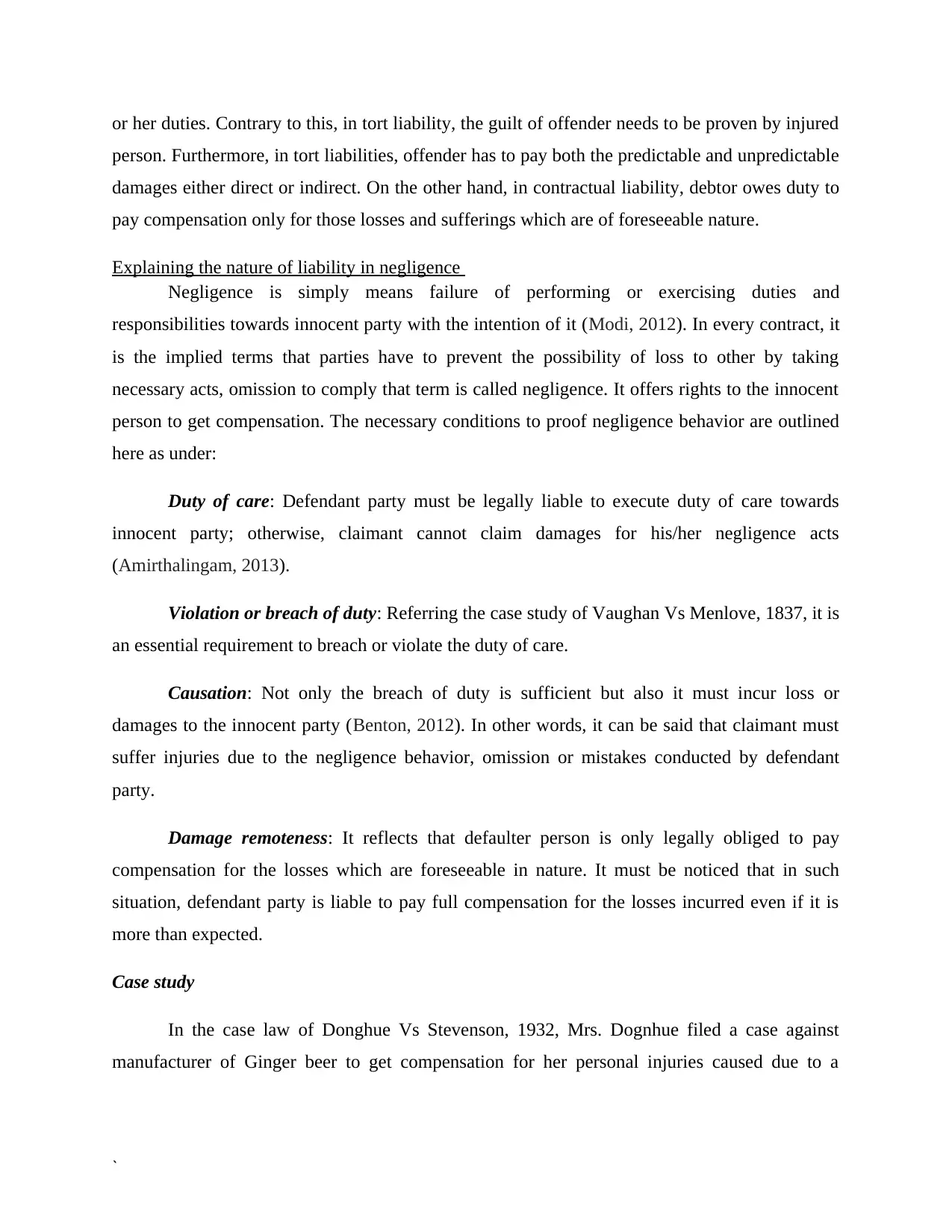
or her duties. Contrary to this, in tort liability, the guilt of offender needs to be proven by injured
person. Furthermore, in tort liabilities, offender has to pay both the predictable and unpredictable
damages either direct or indirect. On the other hand, in contractual liability, debtor owes duty to
pay compensation only for those losses and sufferings which are of foreseeable nature.
Explaining the nature of liability in negligence
Negligence is simply means failure of performing or exercising duties and
responsibilities towards innocent party with the intention of it (Modi, 2012). In every contract, it
is the implied terms that parties have to prevent the possibility of loss to other by taking
necessary acts, omission to comply that term is called negligence. It offers rights to the innocent
person to get compensation. The necessary conditions to proof negligence behavior are outlined
here as under:
Duty of care: Defendant party must be legally liable to execute duty of care towards
innocent party; otherwise, claimant cannot claim damages for his/her negligence acts
(Amirthalingam, 2013).
Violation or breach of duty: Referring the case study of Vaughan Vs Menlove, 1837, it is
an essential requirement to breach or violate the duty of care.
Causation: Not only the breach of duty is sufficient but also it must incur loss or
damages to the innocent party (Benton, 2012). In other words, it can be said that claimant must
suffer injuries due to the negligence behavior, omission or mistakes conducted by defendant
party.
Damage remoteness: It reflects that defaulter person is only legally obliged to pay
compensation for the losses which are foreseeable in nature. It must be noticed that in such
situation, defendant party is liable to pay full compensation for the losses incurred even if it is
more than expected.
Case study
In the case law of Donghue Vs Stevenson, 1932, Mrs. Dognhue filed a case against
manufacturer of Ginger beer to get compensation for her personal injuries caused due to a
`
person. Furthermore, in tort liabilities, offender has to pay both the predictable and unpredictable
damages either direct or indirect. On the other hand, in contractual liability, debtor owes duty to
pay compensation only for those losses and sufferings which are of foreseeable nature.
Explaining the nature of liability in negligence
Negligence is simply means failure of performing or exercising duties and
responsibilities towards innocent party with the intention of it (Modi, 2012). In every contract, it
is the implied terms that parties have to prevent the possibility of loss to other by taking
necessary acts, omission to comply that term is called negligence. It offers rights to the innocent
person to get compensation. The necessary conditions to proof negligence behavior are outlined
here as under:
Duty of care: Defendant party must be legally liable to execute duty of care towards
innocent party; otherwise, claimant cannot claim damages for his/her negligence acts
(Amirthalingam, 2013).
Violation or breach of duty: Referring the case study of Vaughan Vs Menlove, 1837, it is
an essential requirement to breach or violate the duty of care.
Causation: Not only the breach of duty is sufficient but also it must incur loss or
damages to the innocent party (Benton, 2012). In other words, it can be said that claimant must
suffer injuries due to the negligence behavior, omission or mistakes conducted by defendant
party.
Damage remoteness: It reflects that defaulter person is only legally obliged to pay
compensation for the losses which are foreseeable in nature. It must be noticed that in such
situation, defendant party is liable to pay full compensation for the losses incurred even if it is
more than expected.
Case study
In the case law of Donghue Vs Stevenson, 1932, Mrs. Dognhue filed a case against
manufacturer of Ginger beer to get compensation for her personal injuries caused due to a
`

decomposed snail emerged from the bottle. Her claim proven successful and court made
decisions in the favor of her and manufacturer became liable to compensate for the losses.
Vicarious liability of a business
Basically, every person is liable for only himself/herself acts and omissions. However, in
the vicarious liability, this situation is just opposite because an individual is held accountable for
the acts and omissions conducted by the other person. Regards to corporate area, employer has
full rights and control over their employees or workers, henceforth, in case of any mistakes or
omissions conducted by their personnel, employer is held liable (Chamallas, 2014). In order to
comply with the principles of vicarious liability, following are the basic conditions illustrated
below:
The first and foremost prior need to make employer vicarious liable is that there must be
an employer-employee relationship exists at the time of omission occurrences.
Another important thing is that employee must act wrongfully or made mistake during
the course of employment (Damiano, 2013). In other words, it can be said that omission
must be made during working hours, so that, employer can be liable for such occurrences.
TASK 4
Apply the tort of negligence and defences
Following are the defences available to defendant person for his/her negligence actions,
described underneath:
Volenti-non-fit-injuria: According to this defence, claimant only can demand
compensation if defendant perform mistakes or negligence acts intentionally and to cause harm
to innocent party (Handford and McGivern, 2015).
Contributory negligence: If claimant is also liable for the losses and injuries suffered
than defendant party have right to get defence up to the extent to which claimant is liable. In
such situation, defaulter person has to prove that claimant did not perform reasonable care to
ensure his/her own safety, which in turn, caused loss or injuries (Dranove, Ramanarayanan and
Watanabe, 2012). In short, if claimant’s conduct is also the reason for the damages than defence
is always available to defendant.
`
decisions in the favor of her and manufacturer became liable to compensate for the losses.
Vicarious liability of a business
Basically, every person is liable for only himself/herself acts and omissions. However, in
the vicarious liability, this situation is just opposite because an individual is held accountable for
the acts and omissions conducted by the other person. Regards to corporate area, employer has
full rights and control over their employees or workers, henceforth, in case of any mistakes or
omissions conducted by their personnel, employer is held liable (Chamallas, 2014). In order to
comply with the principles of vicarious liability, following are the basic conditions illustrated
below:
The first and foremost prior need to make employer vicarious liable is that there must be
an employer-employee relationship exists at the time of omission occurrences.
Another important thing is that employee must act wrongfully or made mistake during
the course of employment (Damiano, 2013). In other words, it can be said that omission
must be made during working hours, so that, employer can be liable for such occurrences.
TASK 4
Apply the tort of negligence and defences
Following are the defences available to defendant person for his/her negligence actions,
described underneath:
Volenti-non-fit-injuria: According to this defence, claimant only can demand
compensation if defendant perform mistakes or negligence acts intentionally and to cause harm
to innocent party (Handford and McGivern, 2015).
Contributory negligence: If claimant is also liable for the losses and injuries suffered
than defendant party have right to get defence up to the extent to which claimant is liable. In
such situation, defaulter person has to prove that claimant did not perform reasonable care to
ensure his/her own safety, which in turn, caused loss or injuries (Dranove, Ramanarayanan and
Watanabe, 2012). In short, if claimant’s conduct is also the reason for the damages than defence
is always available to defendant.
`
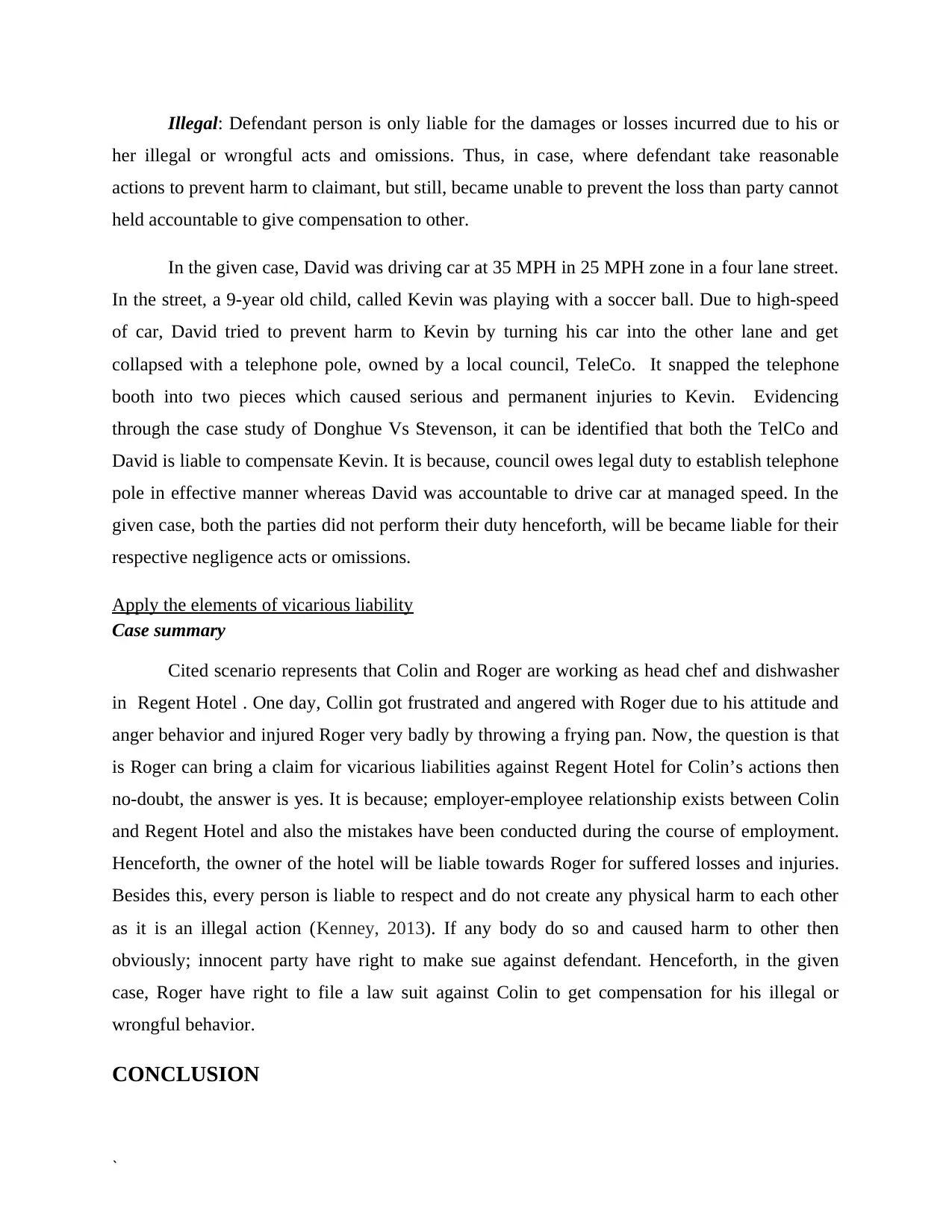
Illegal: Defendant person is only liable for the damages or losses incurred due to his or
her illegal or wrongful acts and omissions. Thus, in case, where defendant take reasonable
actions to prevent harm to claimant, but still, became unable to prevent the loss than party cannot
held accountable to give compensation to other.
In the given case, David was driving car at 35 MPH in 25 MPH zone in a four lane street.
In the street, a 9-year old child, called Kevin was playing with a soccer ball. Due to high-speed
of car, David tried to prevent harm to Kevin by turning his car into the other lane and get
collapsed with a telephone pole, owned by a local council, TeleCo. It snapped the telephone
booth into two pieces which caused serious and permanent injuries to Kevin. Evidencing
through the case study of Donghue Vs Stevenson, it can be identified that both the TelCo and
David is liable to compensate Kevin. It is because, council owes legal duty to establish telephone
pole in effective manner whereas David was accountable to drive car at managed speed. In the
given case, both the parties did not perform their duty henceforth, will be became liable for their
respective negligence acts or omissions.
Apply the elements of vicarious liability
Case summary
Cited scenario represents that Colin and Roger are working as head chef and dishwasher
in Regent Hotel . One day, Collin got frustrated and angered with Roger due to his attitude and
anger behavior and injured Roger very badly by throwing a frying pan. Now, the question is that
is Roger can bring a claim for vicarious liabilities against Regent Hotel for Colin’s actions then
no-doubt, the answer is yes. It is because; employer-employee relationship exists between Colin
and Regent Hotel and also the mistakes have been conducted during the course of employment.
Henceforth, the owner of the hotel will be liable towards Roger for suffered losses and injuries.
Besides this, every person is liable to respect and do not create any physical harm to each other
as it is an illegal action (Kenney, 2013). If any body do so and caused harm to other then
obviously; innocent party have right to make sue against defendant. Henceforth, in the given
case, Roger have right to file a law suit against Colin to get compensation for his illegal or
wrongful behavior.
CONCLUSION
`
her illegal or wrongful acts and omissions. Thus, in case, where defendant take reasonable
actions to prevent harm to claimant, but still, became unable to prevent the loss than party cannot
held accountable to give compensation to other.
In the given case, David was driving car at 35 MPH in 25 MPH zone in a four lane street.
In the street, a 9-year old child, called Kevin was playing with a soccer ball. Due to high-speed
of car, David tried to prevent harm to Kevin by turning his car into the other lane and get
collapsed with a telephone pole, owned by a local council, TeleCo. It snapped the telephone
booth into two pieces which caused serious and permanent injuries to Kevin. Evidencing
through the case study of Donghue Vs Stevenson, it can be identified that both the TelCo and
David is liable to compensate Kevin. It is because, council owes legal duty to establish telephone
pole in effective manner whereas David was accountable to drive car at managed speed. In the
given case, both the parties did not perform their duty henceforth, will be became liable for their
respective negligence acts or omissions.
Apply the elements of vicarious liability
Case summary
Cited scenario represents that Colin and Roger are working as head chef and dishwasher
in Regent Hotel . One day, Collin got frustrated and angered with Roger due to his attitude and
anger behavior and injured Roger very badly by throwing a frying pan. Now, the question is that
is Roger can bring a claim for vicarious liabilities against Regent Hotel for Colin’s actions then
no-doubt, the answer is yes. It is because; employer-employee relationship exists between Colin
and Regent Hotel and also the mistakes have been conducted during the course of employment.
Henceforth, the owner of the hotel will be liable towards Roger for suffered losses and injuries.
Besides this, every person is liable to respect and do not create any physical harm to each other
as it is an illegal action (Kenney, 2013). If any body do so and caused harm to other then
obviously; innocent party have right to make sue against defendant. Henceforth, in the given
case, Roger have right to file a law suit against Colin to get compensation for his illegal or
wrongful behavior.
CONCLUSION
`
Secure Best Marks with AI Grader
Need help grading? Try our AI Grader for instant feedback on your assignments.
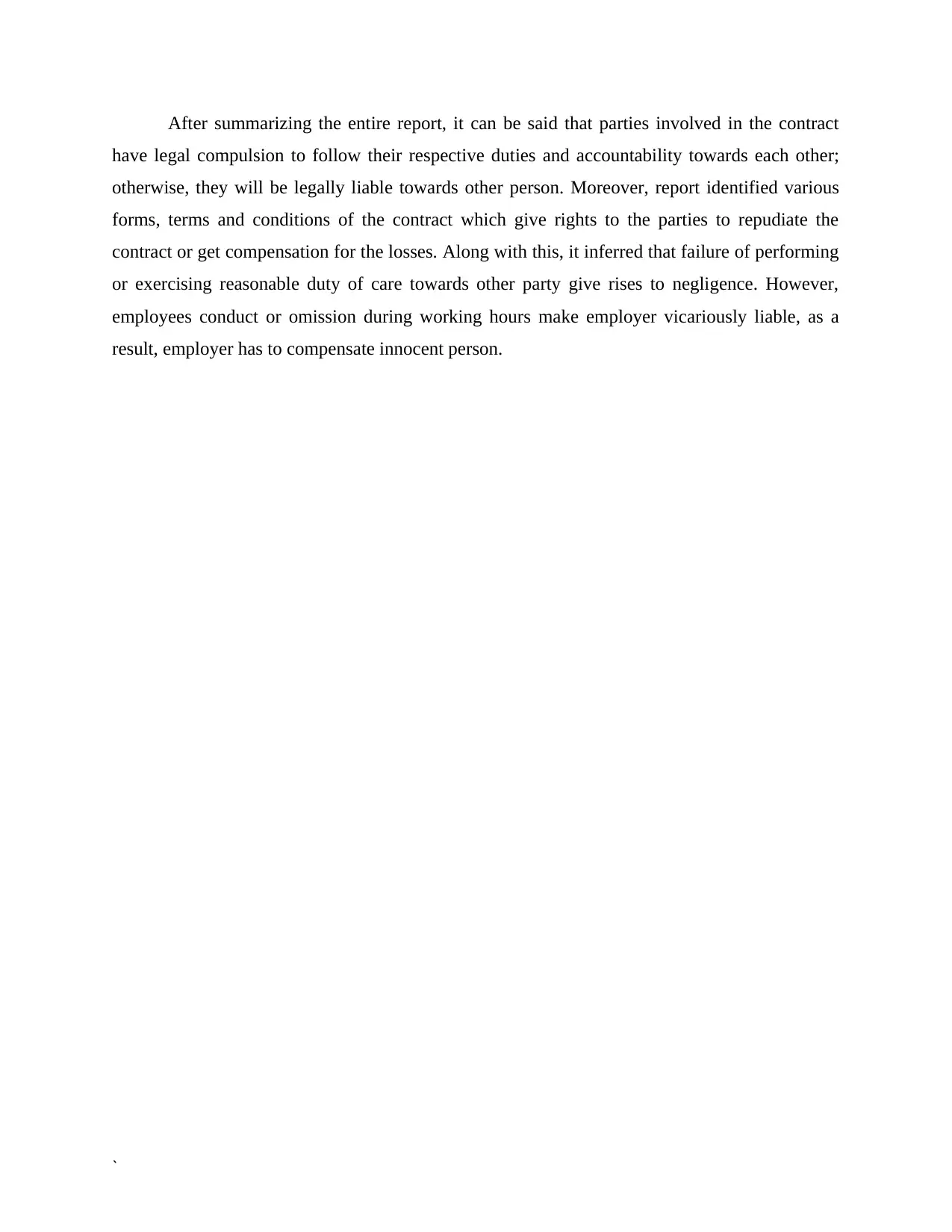
After summarizing the entire report, it can be said that parties involved in the contract
have legal compulsion to follow their respective duties and accountability towards each other;
otherwise, they will be legally liable towards other person. Moreover, report identified various
forms, terms and conditions of the contract which give rights to the parties to repudiate the
contract or get compensation for the losses. Along with this, it inferred that failure of performing
or exercising reasonable duty of care towards other party give rises to negligence. However,
employees conduct or omission during working hours make employer vicariously liable, as a
result, employer has to compensate innocent person.
`
have legal compulsion to follow their respective duties and accountability towards each other;
otherwise, they will be legally liable towards other person. Moreover, report identified various
forms, terms and conditions of the contract which give rights to the parties to repudiate the
contract or get compensation for the losses. Along with this, it inferred that failure of performing
or exercising reasonable duty of care towards other party give rises to negligence. However,
employees conduct or omission during working hours make employer vicariously liable, as a
result, employer has to compensate innocent person.
`
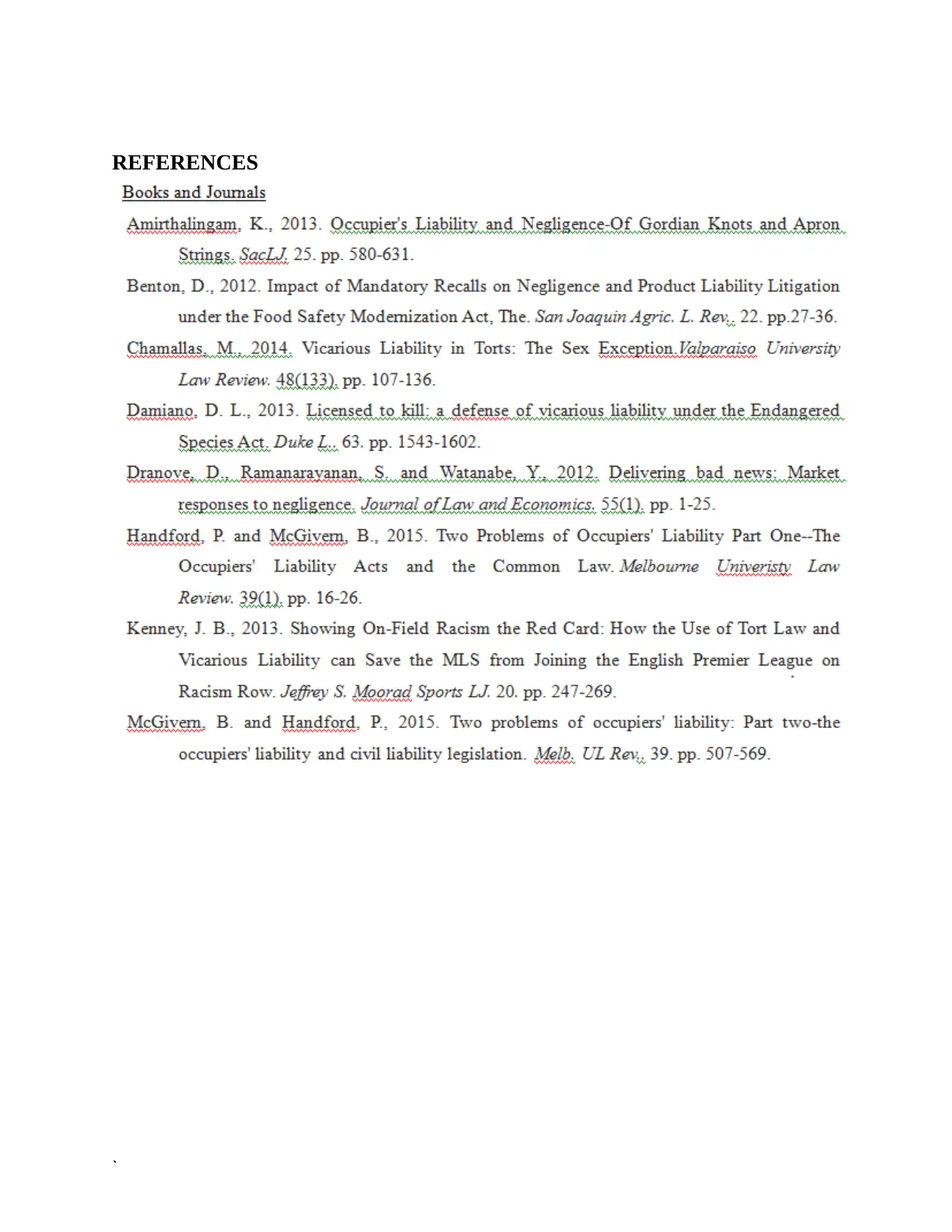
REFERENCES
`
`
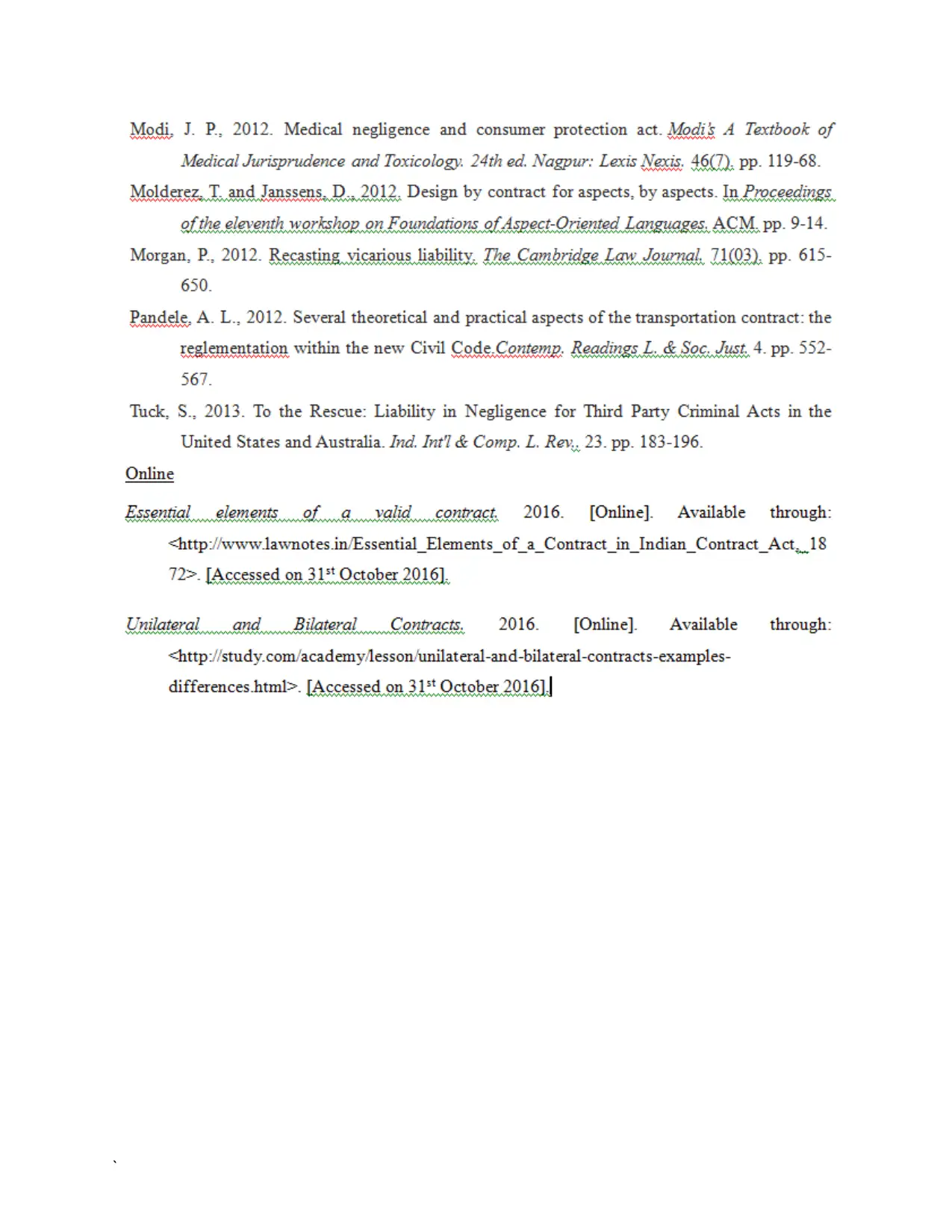
`
1 out of 13
Related Documents
Your All-in-One AI-Powered Toolkit for Academic Success.
+13062052269
info@desklib.com
Available 24*7 on WhatsApp / Email
![[object Object]](/_next/static/media/star-bottom.7253800d.svg)
Unlock your academic potential
© 2024 | Zucol Services PVT LTD | All rights reserved.





